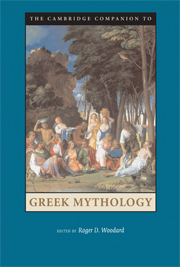Book contents
- Frontmatter
- Introduction: Muthoi in Continuity and Variation
- Part I Sources and Interpretations
- Part II Response, Integration, Representation
- 8 Greek Myth and Greek Religion
- 9 Myth and Greek Art: Creating a Visual Language
- 10 Mythic Landscapes of Greece
- 11 Politics and Greek Myth
- 12 Ovid and Greek Myth
- Part III Reception
- Bibliography
- Index
9 - Myth and Greek Art: Creating a Visual Language
from Part II - Response, Integration, Representation
Published online by Cambridge University Press: 28 March 2009
- Frontmatter
- Introduction: Muthoi in Continuity and Variation
- Part I Sources and Interpretations
- Part II Response, Integration, Representation
- 8 Greek Myth and Greek Religion
- 9 Myth and Greek Art: Creating a Visual Language
- 10 Mythic Landscapes of Greece
- 11 Politics and Greek Myth
- 12 Ovid and Greek Myth
- Part III Reception
- Bibliography
- Index
Summary
In perusing any book devoted to Greek art, one is struck by the ancient Greeks' obsession with their gods, heroes, and mythological creatures. From the earliest extant work of figurative art produced in the so-called Dark Ages, the terracotta centaur from Lefkandi (ca. 950-900 BC), to that icon of late Hellenistic group sculpture, the marble Laocoon (ca. 30-20 BC), Greek artists and their patrons were drawn to mythological subjects not only for their intrinsic interest but also for the important roles they played in explaining the cosmos and shedding light on human nature. Although Greek artists shared this interest in mythological narrative with poets, they did not illustrate written texts; rather, they were guided by that oral culture or Volksvorstellung that was an essential part of every Greek’s upbringing. They, like all artists, were heavily influenced by the work of their predecessors, the demands of the marketplace, and the restrictions imposed by their medium. That said, Greek narrative art displays an amazing degree of imagination, ingenuity, and originality that continues to fascinate today, as it must have engaged viewers in antiquity.
Numerous books, not to mention multivolume lexica, have been devoted to the subject of myth in Greek art. It would be foolhardy to attempt to encompass the entirety of this intriguing and vast topic in a single essay. Therefore, this chapter will examine two specific concerns of Greek painters and sculptors when faced with the challenge of narrating in visual, as opposed to literary, terms a specific story involving gods, heroes, or fantastic creatures. First, what devices did the artist employ for depicting a myth and how did this visual language come about? Second, how did the artist make his chosen theme relevant to a particular audience at a specific point in time?
- Type
- Chapter
- Information
- The Cambridge Companion to Greek Mythology , pp. 286 - 304Publisher: Cambridge University PressPrint publication year: 2007



